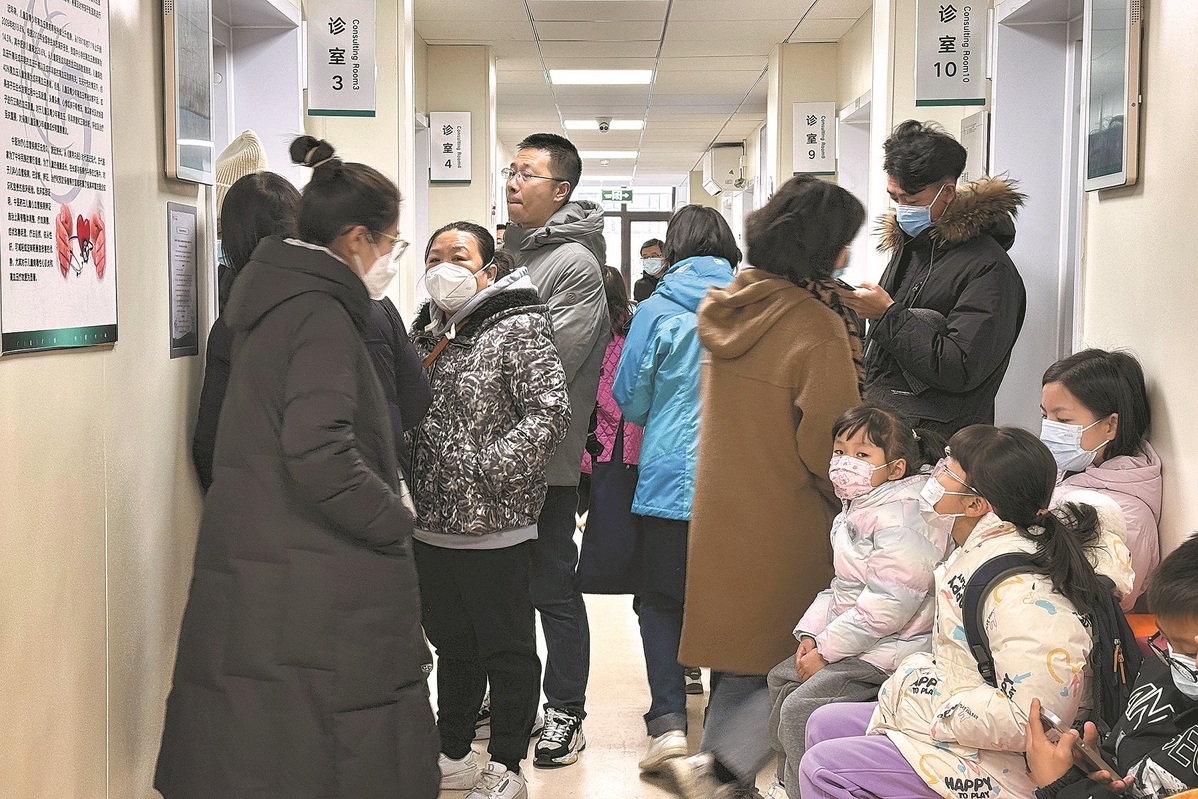Western media's disinformation a much bigger virus - 2023-11-29

Children and parents wait in the pediatrics department at Guang'anmen Hospital in Beijing on Sunday. The capital city has seen a surge in the number of patients with respiratory diseases recently.
Editor's note: China has witnessed a spike in flu cases caused by multiple pathogens. Some Western media outlets unreasonably criticize China for lack of transparency and alleged information concealment, even indicating the outbreak will spread. Two experts share their views on such biased reports with China Daily's Liu Jianna. Excerpts follow:
A medical conundrum for most countries
China's National Health Commission said on Sunday the surge in acute respiratory illnesses was linked to the simultaneous circulation of several kinds of pathogens, most prominently influenza.
In fact such a phenomenon has happened in many countries. Just as Maria Van Kerkhove, acting director of the WHO's department of epidemic and pandemic preparedness and prevention, said the increase appeared to be driven by a rise in the number of children contracting pathogens that they had avoided because of strict measures taken during the COVID-19 pandemic.
In Chinese experts' views, the recent surge in respiratory diseases is a complex phenomenon with various contributing factors, seasonal change, strict pandemic control measures in the past three years that lowered the chance of being infected with other viruses, and enhanced sensitivity in testing. Notably, Zhang Wenhong, a well-known Shanghai-based infectious disease expert, has suggested multiple pathogens are tested in infections may be because testing methods are more sensitive.
While some attribute the upswing to immunocompromised populations, the intricate nature of the situation challenges such simplistic explanations. Climate change emerges as a significant factor, with its intricate influence on disease patterns.
Some foreign media outlets compare the ongoing flu with the early outbreak of COVID-19 in China, accusing China of lack of transparent information. Such accusations are unfounded, given the ongoing challenges faced by healthcare systems globally. Pinpointing specific causative agents in cases remains a challenge not exclusive to China; it is a global conundrum. The complexity arises from the potential coexistence of multiple pathogens within an individual, making clinical diagnosis challenging.
Recent observations suggest an increase in respiratory infections in other countries. The surge in cases in China could partly be attributed to its large population and the sensitivity of its monitoring systems. However, the intricacies of this situation necessitate careful observation, and, according to official tests, there is no evidence of new unknown pathogens emerging.
In conclusion, the surge in respiratory diseases is a multifaceted issue that requires comprehensive analysis. The interplay of climate change, infectious disease control measures, testing methodologies and global epidemiological complexities underscores the need for ongoing observation and research.
The author is Liang Xiaofeng, vice-president of the Chinese Preventive Medicine Association and chair professor of Jinan University.
Only cooperation can stop raging China-phobia
In recent days respiratory diseases have gained attention in China, prompting calls for thorough monitoring and response from the relevant authorities, including the World Health Organization. Despite the spotlight being on these issues, authoritative bodies contend that China's respiratory disease situation is currently within normal parameters. Thus, while vigilance is warranted, there is no need to panic or to succumb to the speculative narratives propagated by some Western media outlets.
The Western media's exaggerated interpretations stem from several factors. First, there is lingering panic in the media as a consequence of the "aftermath" of the COVID-19 pandemic. Second, faced with China's efficient control measures during the pandemic, these media outlets seek to glean more insights from China's experiences and practices. Third, grappling with domestic public safety challenges, some Western media attempt to alleviate their own anxieties by sensationalizing stories related to China.
In the era of global interconnectedness and rapid social dynamics, any nation's public health issues can potentially evolve into global challenges. In contrast to the Western media's distant observation and conspiracy theories, China advocates the concept of a community with a shared future for mankind. China calls for global collaboration in the face of various challenges, emphasizing the need to build a collective force for the well-being of people worldwide. It is through such practices and contributions that China demonstrates its responsibilities and commitments as a major global player.
The author is Zhao Ruhan, a professor at the Institute of Communication Studies, Communication University of China.
Source: China Daily
Application Status
| 04-16 | 21315227 | Processing |
| 03-12 | 21315226 | Processing |
| 09-26 | 21315225 | Processing |
Inquiry Status
| 02-29 | 02131558 | Received |
| 03-06 | 02131557 | Received |
| 11-14 | 02131556 | Received |
FAQ
Q: Q: Is there a place where I can get...
A: A: Log on to http://touch.shio.gov....
A: A: Log on to http://touch.shio.gov....
Q: Q: What is the easiest way to set u...
A: A: 1. Log on to http://touch.shio.g...
A: A: 1. Log on to http://touch.shio.g...
Q: Where can I get an English map of S...
A: English maps of Shanghai are availa...
A: English maps of Shanghai are availa...

